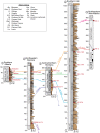Calibrating the zenith of dinosaur diversity in the Campanian of the Western Interior Basin by CA-ID-TIMS U-Pb geochronology
- PMID: 36163377
- PMCID: PMC9512893
- DOI: 10.1038/s41598-022-19896-w
Calibrating the zenith of dinosaur diversity in the Campanian of the Western Interior Basin by CA-ID-TIMS U-Pb geochronology
Abstract
The spectacular fossil fauna and flora preserved in the Upper Cretaceous terrestrial strata of North America's Western Interior Basin record an exceptional peak in the diversification of fossil vertebrates in the Campanian, which has been termed the 'zenith of dinosaur diversity'. The wide latitudinal distribution of rocks and fossils that represent this episode, spanning from northern Mexico to the northern slopes of Alaska, provides a unique opportunity to gain insights into dinosaur paleoecology and to address outstanding questions regarding faunal provinciality in connection to paleogeography and climate. Whereas reliable basin-wide correlations are fundamental to investigations of this sort, three decades of radioisotope geochronology of various vintages and limited compatibility has complicated correlation of distant fossil-bearing successions and given rise to contradictory paleobiogeographic and evolutionary hypotheses. Here we present new U-Pb geochronology by the CA-ID-TIMS method for 16 stratigraphically well constrained bentonite beds, ranging in age from 82.419 ± 0.074 Ma to 73.496 ± 0.039 Ma (2σ internal uncertainties), and the resulting Bayesian age models for six key fossil-bearing formations over a 1600 km latitudinal distance from northwest New Mexico, USA to southern Alberta, Canada. Our high-resolution chronostratigraphic framework for the upper Campanian of the Western Interior Basin reveals that despite their contrasting depositional settings and basin evolution histories, significant age overlap exists between the main fossil-bearing intervals of the Kaiparowits Formation (southern Utah), Judith River Formation (central Montana), Two Medicine Formation (western Montana) and Dinosaur Park Formation (southern Alberta). Pending more extensive paleontologic collecting that would allow more rigorous faunal analyses, our results support a first-order connection between paleoecologic and fossil diversities and help overcome the chronostratigraphic ambiguities that have impeded the testing of proposed models of latitudinal provinciality of dinosaur taxa during the Campanian.
© 2022. The Author(s).
Conflict of interest statement
The authors declare no competing interests.
Figures






References
-
- Sloan, R. E. in Essays on palaeontology in honour of Loris Shano Russell (ed C. S. Churcher) 134–155 (Royal Ontario Museum, 1976).
-
- Dodson PJ. A faunal review of the Judith River (Oldman) Formation, Dinosaur Provincial Park, Alberta. Mosasaur. 1983;1:89–118.
-
- Clemens, W. A. in Dynamics of extinction (ed D. K. Elliott) 63–85 (John Wiley & Sons, 1986).
-
- Dodson, P. J. & Tatarinov, L. P. in The Dinosauria (eds D. B. Weishampel, P. J. Dodson, & H. Osmólska) 55–62 (University of California Press, 1990).
-
- Lehman, T. M. in Dinofest International (eds D. L. Wolberg, E. Stump, & G. D. Rosenberg) 223–240 (Philadelphia Academy of Natural Sciences, 1997).
Publication types
MeSH terms
Substances
LinkOut - more resources
Full Text Sources

